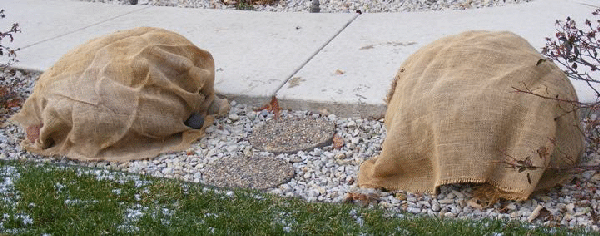Outsmarting Old Man Winter
Your yard is a huge investment and the part of your home that people see every day. It certainly doesn't have to be an elaborate space, but since you've put your effort and money into it, you should hope it would provide you a good return on your investment for many years to come. If taken care of well, it should take limited effort to keep it looking good. If neglected, it will surely show and affect your wallet over time.

One of the most beneficial things you can do for your yard is to winterize it. In frost regions, most people only think about blowing out their irrigation systems, and while that is a great place to start, I look at that exercise as an invitation to put your entire yard to bed for the long winter's nap. This is an important time for plants; more important than we think. Flowers shrink and head below ground, lawns turn brown and dry, but their substructures are still working away throughout the cold.
Deciduous trees and shrubs drop their foliage and put their energy into their root systems, so young trees need trunk protection from the sun. Southern or western sun constantly freezing and thawing tree bark incites sun scald and will cause browning and scarring. It can create a slew of problems, from entry points for insects and weakening of the trunk, to canopy death. Paper wrap, which acts as a kind of sunscreen, can be applied in late fall and removed in early spring. Mulching at least 3-4 inches at the base of young trees also creates a barrier to the cold and prevents excessive moisture loss.

The plants most vulnerable during this time are evergreens. They are green year-round and appear happy all season, but they need more attention than most are given. Coniferous evergreens like spruce and pine and broadleaf evergreens like boxwood and holly retain their foliage and are about the only interesting things that greet us in the landscape. The iconic winter plants are the workhorses of the landscape. They respirate through their needles and leaves. Unfortunately, Colorado is notorious for long, dry spells with wicked mountain wind and even though the soil is moisture-laden clay, the ground does freeze, the available water along with it. Thorough watering in the fall will help initially hydrate evergreens and transition them better through the upcoming temperature drop.
According to Colorado State University Extension, periodic watering when temperatures are above 40 degrees F with no snow cover will ensure their consistency through this harsh time and prevent desiccation and subsequent winter burn. Take care to water mid-day and not to water directly at the base of the trunk. The drip line is the most critical part of the root zone and will uptake water most efficiently. New plants require more frequent watering than those that have been established over a year. A general rule to follow is to apply 10 gallons of water for each diameter inch of the tree trunk, therefore a 2"diameter tree trunk would need 20 gallons per watering.
New shrubs should receive approximately 5 gallons of water twice a month. Small to medium shrubs (3-5'): 5 gallons only once a month and large shrubs (6'+): 18 gallons once per month.


Another method of protection is to screen or wrap foliage in burlap. Structural topiaries and shrubs that are no taller than about head high do well with this application. I recommend my clients wrap twine around columnar evergreens, especially junipers, starting at the trunk and moving upwards. This little bit of up-front work saves branches from splaying out and tearing in heavy snow loads.



The bulk of our Colorado snow seems to come after January and really dumps in the spring. My husband thinks I'm a crazed lunatic running around the yard with a broom knocking snow off tree branches and shrubs. I'm fully aware that I'm incessant about it, but to me it's worth my efforts when I drive around town and see gaping holes on trees from branches ripping and snapping off. I admit, it does give me a fair amount of anxiety when my plants have already leafed out in the spring and are lying almost completely on the ground. My first line of defense aside from my broom is consistent and thoughtful pruning every year. It's not fool-proof, but it goes a long way in preserving the integrity of the structure so that unfortunate damage doesn't occur in the first place.
The Japanese have mastered the process of combating snow damage by making it into a beautiful art form called Yukitsuri. It means "snow suspension" and can be traced back to the 1600's. A very tall bamboo center support pole is erected alongside the trunk and ropes are secured through the canopy of the tree to particular limbs or to a circular structure at ground level. It is meant to disrupt snow accumulation and support the tree's structure. It can take a team of workers anywhere from a couple hours to an entire day to outfit just one tree. The end result, in my opinion, is quite striking and becomes a fitting decoration for the season and the displays are stunning when highlighted at night as well. I love that the Japanese honor and respect their trees and tackle this project every year.


I pride myself on contributing beneficial, timely advice on my local neighborhood social network, educating neighbors and friends on all things landscaping. People have told me the tidbits have been enormously valuable and I hear that they genuinely appreciate a thoughtful post thrown into the ring now and then. I hope this information comes timely enough for you - before any major winter damage is done. If I can save plants and money, I will have done my job.